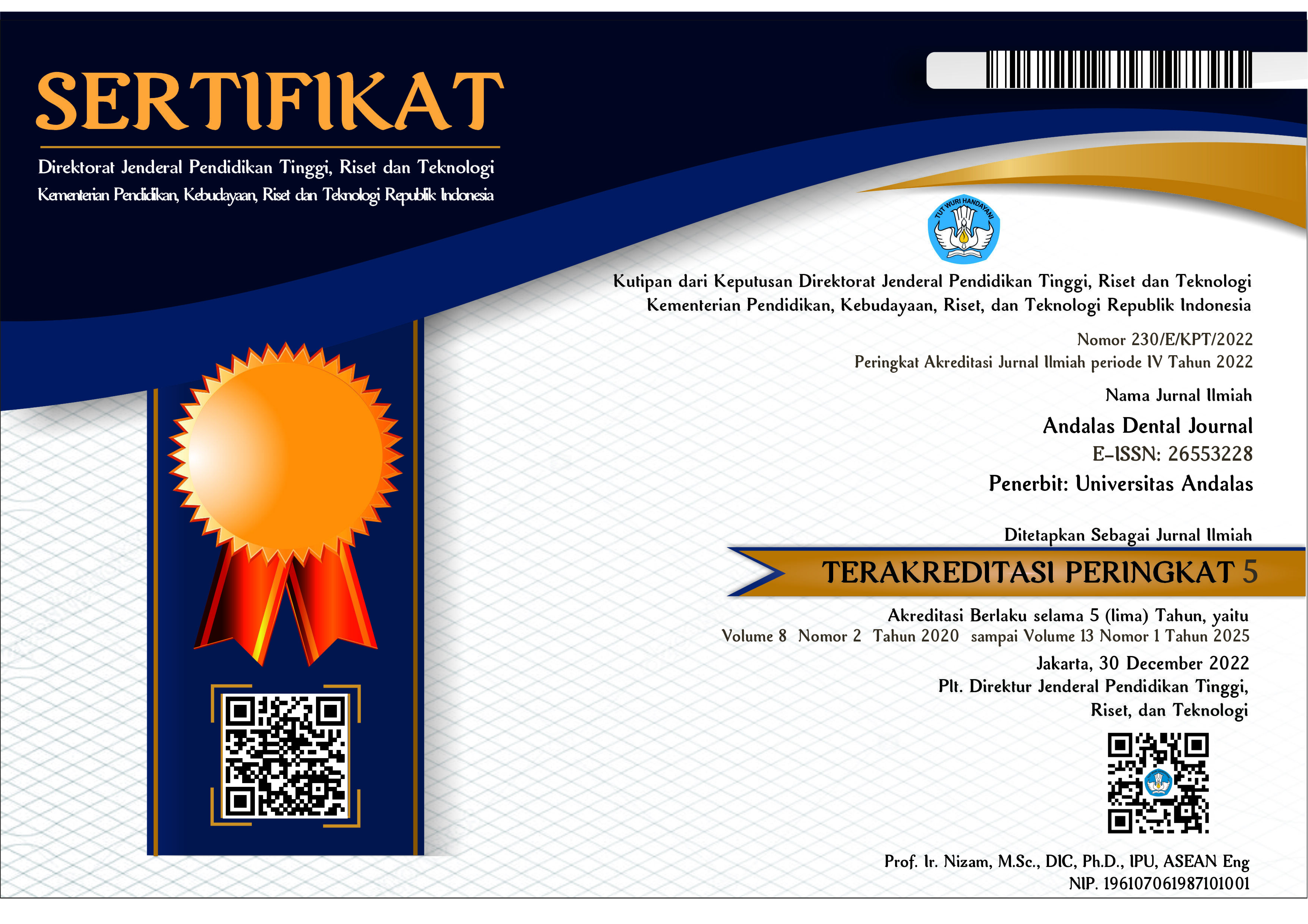Hubungan Lama Pemberian ASI Dengan Tingkat Keparahan Karies Pada Anak Usia 1-2 Tahun Di Posyandu Wilayah Kerja Puskesmas Andalas Kota Padang
Abstract
Background: Early Childhood Caries (ECC) is suspected of tooth decay that occurs in deciduous teeth. ECC is a significant problem in developing countries, which is exacerbated by low social status and malnutrition. Factors that can affect caries transfer in deciduous teeth are milk consumption at night and prolonged breastfeeding. Objective: This study aimed to support the long association of breastfeeding with severity of caries in children aged 1-2 years in the work area of Andalas Health Center, Padang City. Method: This study was an observational study with a cross sectional design. The number of research respondents is 45 children aged 1-2 years who are at the Posyandu in the Andalas Community Health Center working area. All tooth surfaces were evaluated and the scores of each tooth were calculated using a caries severity index. The average score in this study was 1.22 and grouped into three categories. A score of 0 for non-caries, a score of 0 <n <1.22 for mild caries and a score of ≥ 1.22 for severe caries. Analysis of data on the long association of breastfeeding with caries severity was carried out by chi square test. Results: The results of this study prove that the relationship was questioned (p <0.05) on the duration of breastfeeding with the severity of caries in children aged 1-2 years. Conclusion: Breastfeeding has many benefits for children, but provides breast milk for a long time and in the wrong way such as giving breast milk at night until children sleeps without cleaning can increase the risk of caries in children.
References
2. Worotitjan, I., et al., pengalaman karies gigi serta pola makan dan minum pada anak sekolah dasar di desa Kiawa kecamatan Kawangkoan Utara. Jurnal e-Gigi (eG). 2013; 1(1): 60-8.
3. Moreira., Rafael da Silvera. Epidemiology of Dental Caries in the World. Oral Health Care Research. 2012: 150-168.
4. Revina, NE., Sri, S., Anne, AS., Kesehatan gigi dan mulut terkait kualitas hidup anak usia 4-5 tahun di Desa Cilayung. Departemen ilmu kesehatan Gigi Masyarakat, Fakultas Kedokteran Gigi, Universitas Padjajaran. Bandung; 2018.
5. Seow, WK., et al., Case-control study of early childhood caries in Australia. Caries Res. 2009; 43: 25-35
6. Vahirarojpisan, T., et al., Detsomboonrat P. Early childhood caries in children aged 6−19 Months. Community Dent Oral Epidemiology. 2004.
7. Yuyus, R.., Magdarina, DA., F Sintawati. Karies Gigi Pada Anak Balita Di 5 Wilayah DKI. Cermin Dunia Kedokteran. 2002; (134): 39–41.
8. Badan Penelitian Dan Pengembangan Kesehatan Kementrian Kesehatan RI. Riset kesehatan dasar; 2013.
9. Chemiawan, E., Gartika, M., Indriyanti R., Perbedaan prevalensi karies pada anak sekolah dasar dengan program UKGS dan tanpa UKGS Kota Bandung. Universitas Padjajaran; 2004.
10. World Health Organization. 10 fact on breastfeeding; 2014.
11. Kramer, MS., Kakuma, R., Optimal duration of exlusive breastfeeding. Cochrane Database Syst Rev. 2012; (8): CD003517.
12. American Academy of Pediatrics. Breastfeeding and the use of human milk. Pediatricsn. 2012; 129: e827-e841.
13. Lingling, Cui., et al., Breasfeeding and early childhood caries : a meta-analysis of observational studies. Asia Pac J Clin Nutr. 2017; 26(5) : 867-880.
14. Tanaka, K., Yoshihiro, M., Association between breastfeeding and dental caries in Japanes children. Dapartment of Preventive Medicine and Public Health, Faculty of Medicine, Fukuoka University, Japan. Journal Epidemiol. 2011; 22(1): 72-77.
15. Nirunsittirat, A., et al., Breastfeeding duration and Childhood Caries : A Cohort Study. Dapartment of Community Dentistry, Faculty of Dentistry, Khon Kaen University. 2016; 50: 498-507.
16. Bazar, O., et al., Caries activity test in mongolian and japanese children. Department of Behavioral Pediatric Dentistry, Okayama University. Article in Pediatric Dental Journal. 2004; 14(1): 61-67.
17. Junaidi., Madarina, J., Julita, H., Hubungan keparahan karies gigi dengan konsumsi zat gizi dan status gizi anak sekolah dasar di Kecamatan Lhoknga Kabupaten Aceh Besar. Jurnal Gizi Klinik Indonesia. 2007; 4(2): 92-96.
18. Prabhakar, AR., Kurthukoti, AJ., Gupta, P., Cariogenicityand aciodogenicity of human milk, plain and sweetened bovine milk: an in vitro study. J Clin Pediatr Dent. 2010; 34(3): 239-247.
19. Sabandar, Alfons O., Hubungan antara lama menyusui dengan terjadinya karies gigi pada murid TK warga Kelurahan Gandekan Surakarta. Surakarta: FK Universitas Sebelas Maret; 2005.
20. Donna, L. Buku ajar keperawatan pediatrik. Jakarta: EGC. 2009; 1(6).
21. Melanie, S., A-Z Kesehatan gigi panduan lengkap kesehatan gigi keluarga. Solo: Tiga Serangkai Pustaka Mandiri; 2011.
22. Salone, LR., Van, WF., Dee, DL., Breastfeeding: An overview of oral and general health benefits. J Am Dent Assoc. 2013; 144: 143-151.
23. Salone, LR., Van, WF., Dee, DL., Breastfeeding: An overview of oral and general health benefits. J Am Dent Assoc. 2013; 144: 143-151.
24. Dinas Kesehatan Kota Padang. Laporan pelayanan program kesehatan gigi dan mulut puskesmas kota padang. Padang. 2018.
Copyright (c) 2021 Dilla Azana Fitri, Bambang Ristiono, Hidayati Hidayati

This work is licensed under a Creative Commons Attribution-ShareAlike 4.0 International License.















